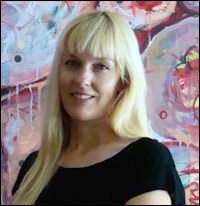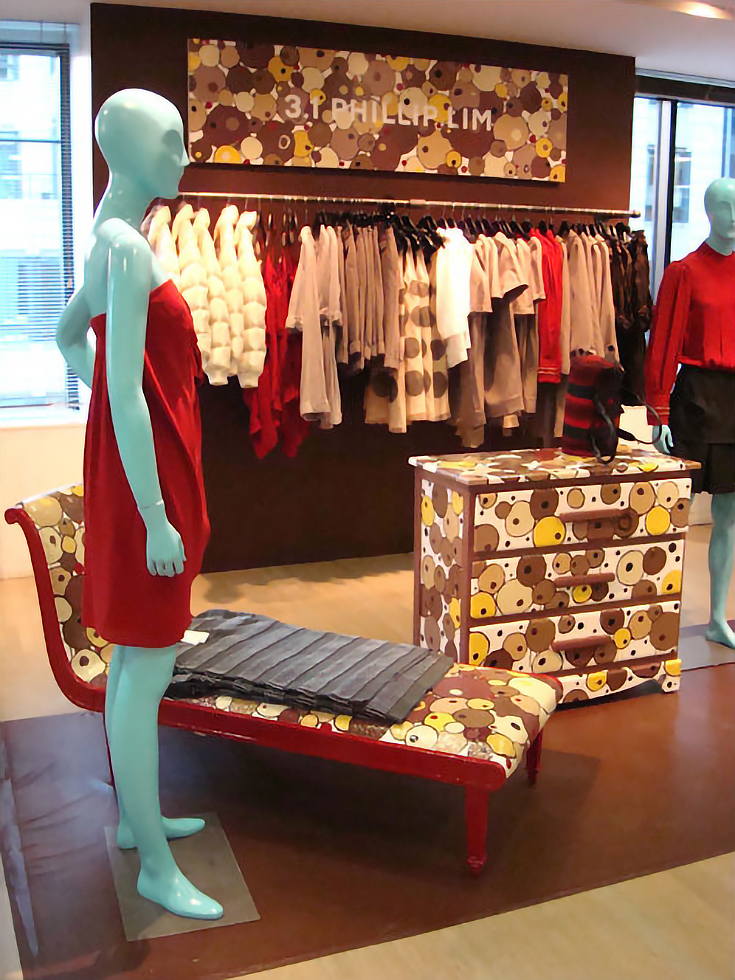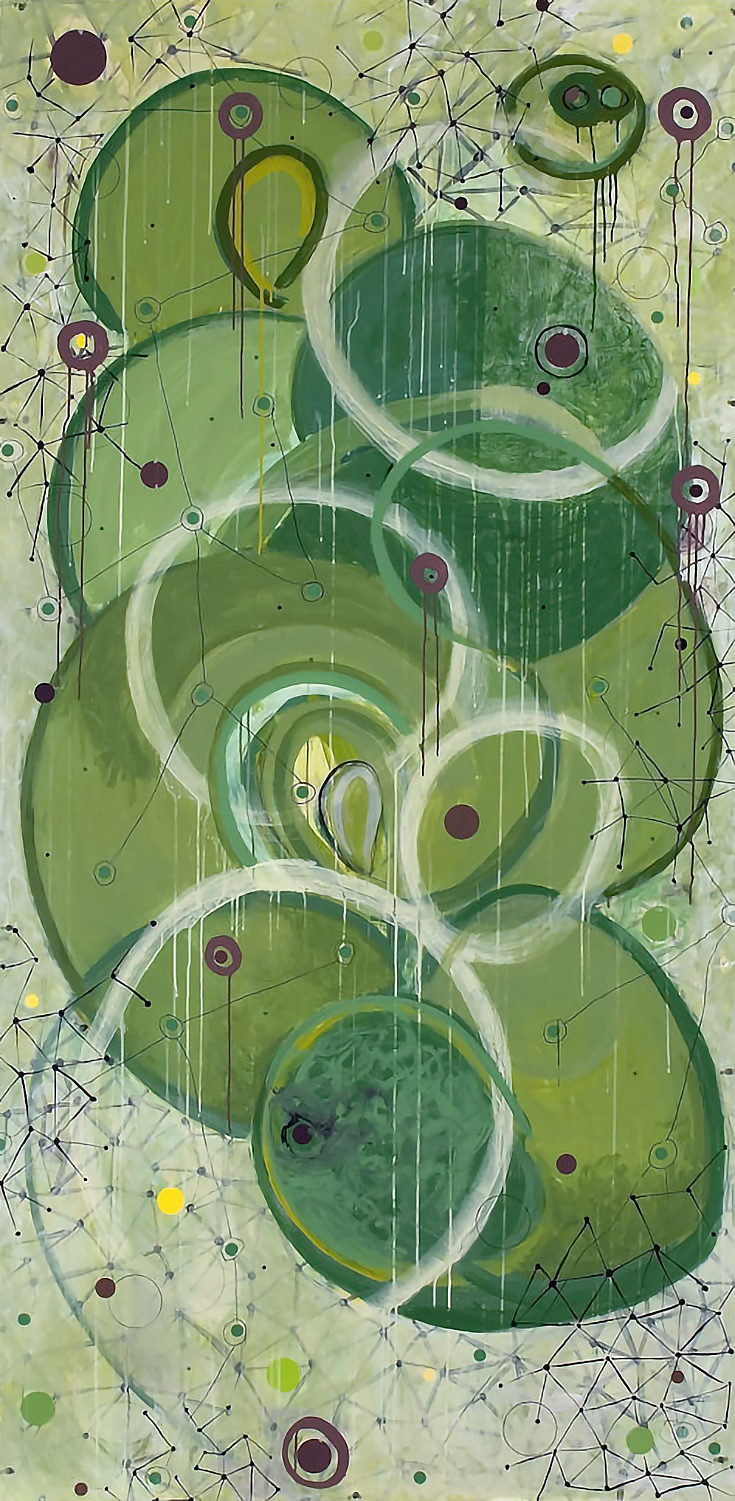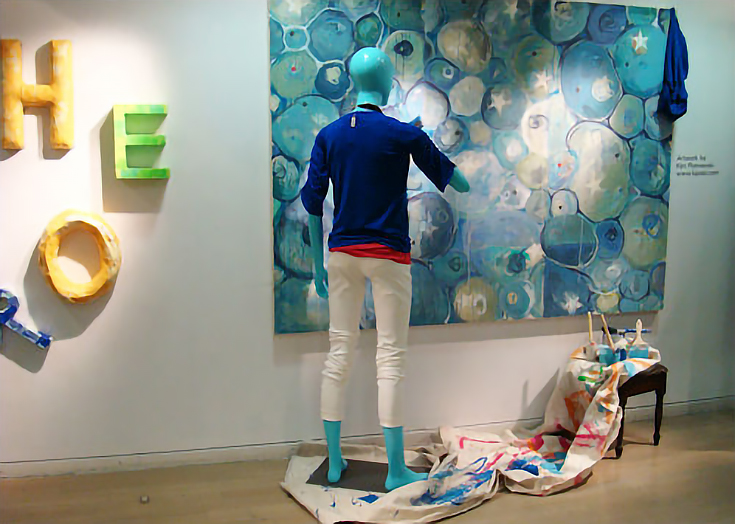
Her work has appeared as store props in Barneys Department Store in Midtown Manhattan, she has collaborated with a young Brooklyn designer to create a print for the 2012 New York’s Fashion Week, and she has sold her work to art collectors all over the world.
Alyice: How long have you been an artist and how did you get started?
Kim: I’ve been an artist since I can remember. . . I have a photo that my dad took of me in the 70s when I was about seven or eight; I am very busy painting dough ornaments. Forget the actual baking—painting was by far the best part!
I also made holiday decorations at my little craft table for display, on our front door, out of construction paper, markers, pipe cleaners, and glitter. In a way, the front door was my first gallery.
Our house was a creative one. My mom sewed all of my clothes, and my own artistic endeavors were furthered by my dad who taught me stained glass, glass etching, and black and white photography.
The sense of accomplishment when you finally step back and get a painting twisted and molded into what you want it to look like pleases me like nothing else in the world.
Alyice: What’s your background in art?
Kim: As I was growing up, I drew and painted and made all sorts of craft projects all the time. . . on weekends and in between homework.
You name it, I tried it—spin art, fashion plates, paint by number kits, spirograph—all that good retro stuff. I also took traditional painting and drawing classes for enrichment at Fleischer Art School in Philadelphia on weekends during the school year. As I ascended the steps of the school every Saturday, the smell of oils and turpentine was always a welcoming smell. I’m happy to see that the school still has its doors open with similar programs for kids (and adults) like me.
As I got older, I switched my initial program from pre-med to art. I loved biology and looking through microscopes, but chemistry and ultimately, the emergency room/surgery lifestyle wasn’t for me. By painting science and math (fractals) I combined everything that I loved all at once.
Later, I went to graduate school at Pratt Institute majoring in both painting and art history.
Alyice: Why did you choose acrylic as your medium?
Kim: I have tried all sorts of art mediums throughout my days making art—watercolors, crayons, color pencils, cray-pas, and above all, oils. As I moved out of that formal educational environment and into an apartment where I created a working studio right in my living space, I didn’t want the fumes that came with working in oils.
Forced by being in a combined live/work situation, I converted almost immediately with no real background in acrylic paints. I just gave it a shot and started working.
Alyice: What is the most challenging part about working with acrylics?
Kim: They dry very quickly so you have to make decisions fast. Working with oils, it can take up to two weeks for an area to dry completely.
If something doesn’t look right to me, I wipe it away immediately. Painting over it later isn’t always the answer.
The other challenge with acrylic paints is that I also end up wasting a lot of paint after I mixed and prepared several colors because of that speedy drying time. And though I keep them in sealed takeout containers, the air still gets in there somehow if I don’t use them up fast enough.
Alyice: What is the best part about working with acrylics?
Kim: Now that I am used to working in this medium, I also like that same fast drying time. It has its advantages. I like instant results and instant gratification when I’m working. I can see what the work is going to be like almost immediately. I can also walk away from the work for about an hour when everything is wet then come back and keep working without the colors getting muddy as they do with oils.
Alyice: What do you wish you knew about acrylics before you got started?
Kim: There are so many different additives, extenders, and other mediums (I like to call them “accessories”) that you can put in the paint to create different effects and even slow down the drying process.
I’m a purist and pretty straightforward when it comes to painting, so I haven’t really tried many of them to create those different effects. Who knows? Maybe one or two would make my life easier in some way!
Someday, I’d like to buy a bunch of those different bottles of various clear liquids and pastes that I see on the shelves of art stores and just experiment; just to know and understand the differences between them like I used to understand linseed oil and mineral spirits.
Alyice: Do you do anything in particular to seal your art?
Kim: It depends on the piece. For the most part, I think acrylics are self-protective by their nature.
Generally, I don’t put anything additional to protect the work. For one or two pieces, I’ve tried pouring on a clear medium. Sometimes I like the effect, but ultimately, it makes the piece look too plastic and shiny; making it difficult to photograph.
Alyice: What is your creative process like?
Kim: I’ve often made small sketches with the intent of having them look the same in a larger version. It NEVER happens! I like the idea of making a sketch to get something off of my brain, but as an art practice, it’s almost like creating two totally different pieces. My mind’s eye always sees something different when I actually start working in a larger format. You could also call it “going off script.”
Alyice: How has your style changed over the years?
Kim: Thematically, my adult work is still the same. It’s science or math based. When I first changed my major to art in college, I painted very structured and exact cellular representations from my biological studies.
My dad also introduced me to the idea of fractals. I was fascinated by their concept and arbitrary color schemes.
My work then shifted into a more generic circular form. For some pieces, I still work this way. My smaller work is now pattern-based but still has a scientific bent to it.
Alyice: What do you believe is a key element in creating a good composition?
Kim: Balance and good colors.
I gravitate towards pattern and dynamic, vibrant color. I want the piece overall to be self-similar but not identical in all areas. I include elements all over the piece and some are not immediately seen through portions that are translucent or opaque. That way, your eye bounces around the piece constantly looking for some sort of inconsistency. The more you look at it, the more you keep finding new things.
Alyice: How do you come up with a profitable pricing structure for your acrylic pieces?
Kim: That part has been a definite challenge for me. I’m not so great at it and everything is so arbitrary.
As a guideline, I base my pricing on size, how long it took me to make it, my expenses, and how successful it is as a piece overall.
Commissions are a totally different story. Again, there are so many elements involved. My acrylic pieces (both on canvas and paper) tend to be quite large (approximately 4-5 feet plus). I’ve found that most (but not all) people are intimidated by committing to the scale of such a piece.
For more on Kim Piotrowski visit www.kipiski.com or kipiboo.blogspot.com.
This post may contain affiliate links.




